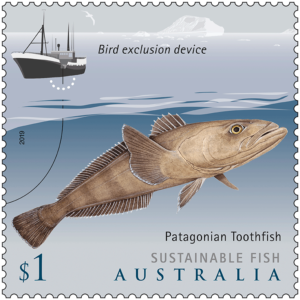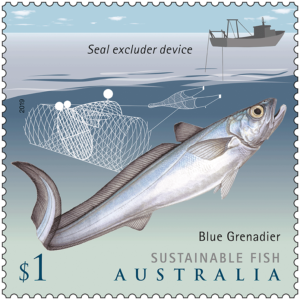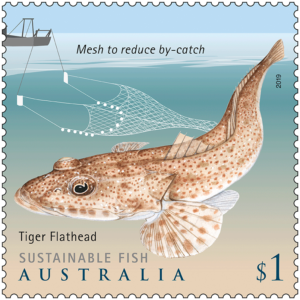[press release]
Stamps focus on fishing for a sustainable future Coinciding with Sustainable Seafood Week 2019 (11-17 March) Australia Post is releasing three striking stamps featuring sustainable fish species on Thursday.
Coinciding with Sustainable Seafood Week 2019 (11-17 March) Australia Post is releasing three striking stamps featuring sustainable fish species on Thursday.
Australia rates highly internationally when it comes to commercial fishing practices, and was the first country in the world to receive independent certification of one of its fisheries from the Marine Stewardship Council.
Professor of Marine System Management at the University of Tasmania Keith Sainsbury, who consulted with Australia Post on the stamps, said: “Sustainable fishing requires keeping fishing to a level that allows it to continue indefinitely, maintaining the integrity of ecosystems, and utilising non-destructive, wild-capture fishing techniques. Encouraging these practices on a global scale is critical to maintaining adequate fish levels and minimising harm to the natural environment.”
The stamps are designed by Sonia Young of the Australia Post Design Studio, using illustrations by Dr Lindsay Marshall, a natural history artist and PhD in shark morphology and fisheries science. The domestic base-rate ($1) stamps feature three sustainable Australian fish species, along with the relevant commercial fishing technique used to minimise environmental impacts.
 Patagonian Toothfish (Dissostichus eleginoides) is a large and slender deep-water species. Commercial Patagonian Toothfish fisheries are located in the Southern Ocean and the Ross Sea. Fisheries have developed practices and devices to minimise seabird interactions with longlines, including the use of a bird exclusion device. The device forms a physical and visual barrier around the area where line hauling occurs, preventing seabirds from accessing baited hooks.
Patagonian Toothfish (Dissostichus eleginoides) is a large and slender deep-water species. Commercial Patagonian Toothfish fisheries are located in the Southern Ocean and the Ross Sea. Fisheries have developed practices and devices to minimise seabird interactions with longlines, including the use of a bird exclusion device. The device forms a physical and visual barrier around the area where line hauling occurs, preventing seabirds from accessing baited hooks.
 Blue Grenadier (Macruronus novaezelandiae) , also known as Hoki, is a bottom-dwelling deep-water fish found in temperate marine waters off New Zealand and Australia. Commercial Blue Grenadier fisheries are located in south-east and southern Australia and off the west coast of Tasmania. Special Seal Excluder Devices (SEDs) are used in fishing nets to help seals swim out nets if they are accidentally caught.
Blue Grenadier (Macruronus novaezelandiae) , also known as Hoki, is a bottom-dwelling deep-water fish found in temperate marine waters off New Zealand and Australia. Commercial Blue Grenadier fisheries are located in south-east and southern Australia and off the west coast of Tasmania. Special Seal Excluder Devices (SEDs) are used in fishing nets to help seals swim out nets if they are accidentally caught.
 Tiger Flathead (Platycephalus richardsoni) is found from northern New South Wales to western Victoria, including Tasmanian waters. The commercial Tiger Flathead fisheries are located in south-eastern Australia and the Great Australian Bight, and use differently sized mesh in different parts of the fishing net to help non-target or undersized fish to escape.
Tiger Flathead (Platycephalus richardsoni) is found from northern New South Wales to western Victoria, including Tasmanian waters. The commercial Tiger Flathead fisheries are located in south-eastern Australia and the Great Australian Bight, and use differently sized mesh in different parts of the fishing net to help non-target or undersized fish to escape.
Products associated with this issue include a first day cover, stamp pack, set of maxicards, minisheet and a booklet of 10 x $1 self-adhesive stamps. The stamps and associated products are available at participating Post Offices, via mail order on 1800 331 794 and online at auspost.com.au/stamps, from Thursday 14 March 2019 while stocks last.



